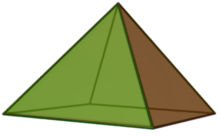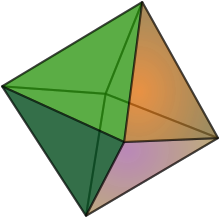Convex hull of indicator vectors of bases
In mathematics, a matroid polytope, also called a matroid basis polytope (or basis matroid polytope) to distinguish it from other polytopes derived from a matroid, is a polytope constructed via the bases of a matroid. Given a matroid  , the matroid polytope
, the matroid polytope  is the convex hull of the indicator vectors of the bases of
is the convex hull of the indicator vectors of the bases of  .
.
Related polytopes
Independence matroid polytope
The matroid independence polytope or independence matroid polytope is the convex hull of the set

The (basis) matroid polytope is a face of the independence matroid polytope. Given the rank  of a matroid
of a matroid  , the independence matroid polytope is equal to the polymatroid determined by
, the independence matroid polytope is equal to the polymatroid determined by  .
.
Flag matroid polytope
The flag matroid polytope is another polytope constructed from the bases of matroids. A flag  is a strictly increasing sequence
is a strictly increasing sequence

of finite sets.[4] Let  be the cardinality of the set
be the cardinality of the set  . Two matroids
. Two matroids  and
and  are said to be concordant if their rank functions satisfy
are said to be concordant if their rank functions satisfy

Given pairwise concordant matroids  on the ground set
on the ground set  with ranks
with ranks  , consider the collection of flags
, consider the collection of flags  where
where  is a basis of the matroid
is a basis of the matroid  and
and  . Such a collection of flags is a flag matroid
. Such a collection of flags is a flag matroid  . The matroids
. The matroids  are called the constituents of
are called the constituents of  .
For each flag
.
For each flag  in a flag matroid
in a flag matroid  , let
, let  be the sum of the indicator vectors of each basis in
be the sum of the indicator vectors of each basis in 

Given a flag matroid  , the flag matroid polytope
, the flag matroid polytope  is the convex hull of the set
is the convex hull of the set

A flag matroid polytope can be written as a Minkowski sum of the (basis) matroid polytopes of the constituent matroids:[4]






















































